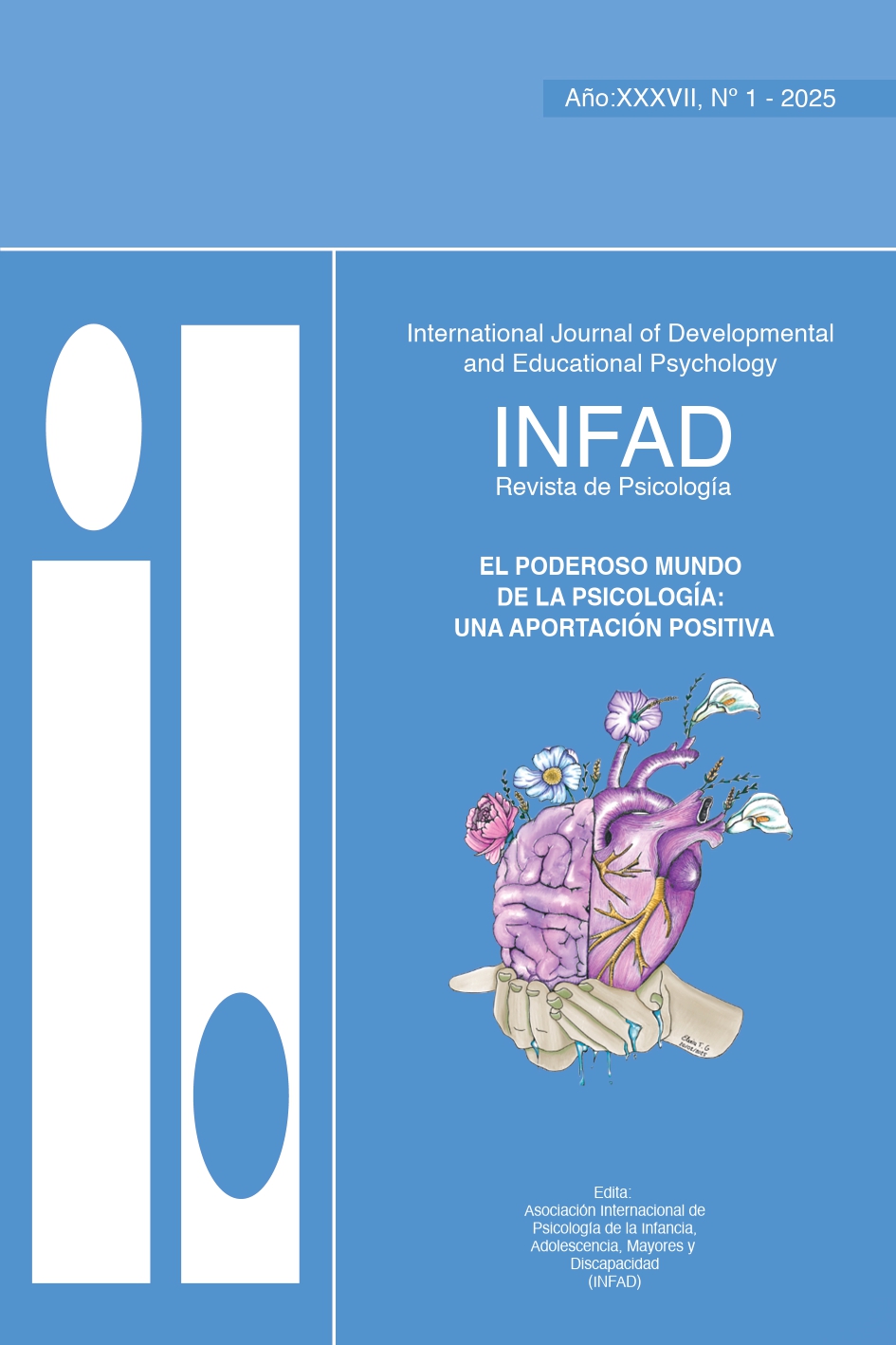Alteration of beliefs in women victims of gender violence and their relationship with the reporting process
Main Article Content
Abstract
The present study aims to analyze the alterations in beliefs among women who have experienced gender-based violence and their potential relationship with the process of reporting the criminal offense. To this end, the study examines negative beliefs about the self; negative beliefs about the world and the future; negative beliefs about others; as well as negative beliefs related to guilt and self-sabotage. The goal is to determine whether there is a significant relationship between the alteration of these beliefs and the act of reporting the violence suffered, within a sample of 26 women who are victims of gender-based violence. This analysis is conducted using the Belief Alteration Subscale of the Trauma Impact Questionnaire (CIT). The results show that there are significant variables related to the impact of trauma that are highly relevant to the study of belief alterations in female victims. These variables are interrelated; however, they do not show a significant relationship with the process of reporting gender-based violence. Finally, this study contributes to a better understanding of how the psychological effects of trauma resulting from gender-based violence can have broader social and criminological implications.
Article Details
Section

This work is licensed under a Creative Commons Attribution-NonCommercial-NoDerivatives 4.0 International License.
Attribution — You must give appropriate credit, provide a link to the license, and indicate if changes were made. You may do so in any reasonable manner, but not in any way that suggests the licensor endorses you or your use.
NonCommercial — You may not use the material for commercial purposes.
NoDerivatives — If you remix, transform, or build upon the material, you may not distribute the modified material.

This work is licensed under a Creative Commons Attribution-NonCommercial-NoDerivatives 4.0 International License
How to Cite
References
Amnistía Internacional. (2023). Derechos de las mujeres . Recuperado de: https://www.amnesty.org/es/what-we-do/discrimination/womens-rights/
Amor, P. J., Echeburúa, E., Corral, P., Sarasua, B. y Zubizarreta, I. (2001). Maltrato físico y maltrato psicológico en mujeres víctimas de violencia en el hogar: un estudio comparativo. Revista de Psicopatología y Psicología Clínica , 6 (3), 167-178.
Cáceres-Ortiz, E., Labrador-Encinas, F., Ardila-Mantilla, P. y Parada-Ortiz, D. (2011). Tratamiento cognitivo conductual centrado en el trauma de mujeres víctimas de violencia de pareja. Psychologia. Avances de la Disciplina , 5 (2), 13-31.
Caro, I. (2011). Hacia una práctica eficaz de las psicoterapias cognitivas . Desclée de Brouwer.
Centro de Investigaciones Sociológicas (CIS). (2023). Percepciones sobre la igualdad entre hombres y mujeres y estereotipos de género. Recuperado de: https://bit.ly/4kN1MCh
Consejo General del Poder Judicial (CGPJ). 2024. Violencia sobre la mujer. Recuperado de: https://www.poder-judicial.es/cgpj/es/Temas/Estadistica-Judicial/Estadistica-por-temas/Datos-penales—civiles-y-laborales/Violencia-domestica-y-Violencia-de-genero/Datos-sobre-Violencia-sobre-la-mujer-en-la-estadistica-del-CGPJ/
Crespo, M., González-Ordi, H., Gómez-Gutiérrez, M. y Santamaría P. (2020). Cuestionario del Impacto del Trauma (CIT). TEA Ediciones.
De Miguel Álvaro, A. (2024). Estrés postraumático y violencia contra la mujer en la pareja: desarrollo y evaluación de un tratamiento centrado en las memorias positivas.
Faulk, M. (1974). Men who assault their wives. Medicine, Science and the Law, 14 , 180-183.
Ferrer Pérez, V. A. y Bosch Fiol, E. (2016). Barreras que dificultan la denuncia de la violencia de género: reflexiones a propósito de los resultados de la macroencuesta. En Mujeres e investigación. Aportaciones interdisciplinares: VI Congreso Universitario Internacional Investigación y Género (pp. 256-270).
Flores, A. y Velasco, C. (2004). Miedos y creencia irracionales en mujeres víctimas de violencia conyugal. Ajayu Órgano de Difusión Científica del Departamento de Psicología UCBSP , 2 (1), 31-44.
Gil, E. B. (2013). “Voy o no voy”: el recurso a la policía en el caso de la violencia de género. Perspectivas de las víctimas. Estudios Penales y Criminológicos , 33, 369-400.
Herrera, S. M. M. y de la Roca Chiapas, J. M. (2024). Factores determinantes de la resiliencia y creencias sobre violencia de género en mujeres mexicanas. Educateconciencia , 32 (1), 6-20.
Janoff-Bulman, R. (1992). Shattered assumptions: Towards a new psychology of trauma. Free Press, 256 , 222-225.
LaBar, K. S. (2007). Beyond Fear: Emotional Memory Mechanisms in the Human Brain. Current Directions in Psychological Science, 16(4), 173-177. https://doi.org/10.1111/j.1467-8721.2007.00498.x
Laliga, M. y Bonilla, A. (2015): Políticas públicas en el tratamiento de la violencia de género: una aproximación crítica a la eficacia de las herramientas jurídicas y alternativas. Journal of Feminist and Women Studies, 1, 41-51.
Ley Orgánica 1/2004, de 28 de diciembre, de Medidas de Protección Integral contra la Violencia de Género. 29 de diciembre de 2004. BOE N. º 313. Recuperado de: https://www.boe.es/eli/es/lo/2004/12/28/1/con
Llerena, S. (2017). Creencias irracionales y dependencia emocional [Tesis para optar el título de Psicólogo Clínico]. Universidad Técnica de Ambato. https://repositorio.uta.edu.ec/bitstream/123456789/25175/2/TESIS%20TER-MIN ADA%20STEFAN%C3%8DA%20LLERENA%20FREIRE%202.pdf
Mainieri, R. (2012). El Modelo de la Terapia Cognitivo Conductual . Sepas Editorial.
Ministerio de Igualdad. Delegación del Gobierno contra la violencia de género. (2019). Macroencuesta de violencia contra la mujer 2019. Recuperado de: https://violenciagenero.igualdad.gob.es/macroencuesta2015/macroencuesta2019/
Ministerio de Igualdad. Delegación del Gobierno contra la Violencia de Genero. (2022). Encuesta europea de violencia de género 2022 . Recuperado de: https://violenciagenero.igualdad.gob.es/violenciaencifras/encuesta_europea/
Oblitas, L. (2004). Manual de psicología clínica y de la salud hospitalaria . Psicom Editores.
Pérez, L. F. A., Fernández, E. F., y Duarte, K. N. (2024). Evaluación pericial psicológico-forense del trastorno por estrés postraumático complejo en víctimas de violencia de género. Revista Española de Medicina Legal, 50 (2), 76-81.
Real Academia Española. (1925). Diccionario de la lengua española (Vol.1). Talleres Calpe.
Sanz-Barbero, B., Rey, L. y Otero-García, L. (2014). Estado de salud y violencia contra la mujer en la pareja. Gaceta Sanitaria , 28 , 102-108.
Shainess, N. (1974). Sexual problems of women. Journal of Sex & Marital Therapy , 1 (2), 110-123.
Snell, J. E., Rosenwald, R. J. y Robey, A. (1964). The wifebeater’s wife: A study of family interaction. Archives of General Psychiatry , 11 (2), 107-112.
Villavicencio, P. (1993). Mujeres maltratadas: Conceptualización y evaluación. Clínica y Salud , 4 (3), 215.

